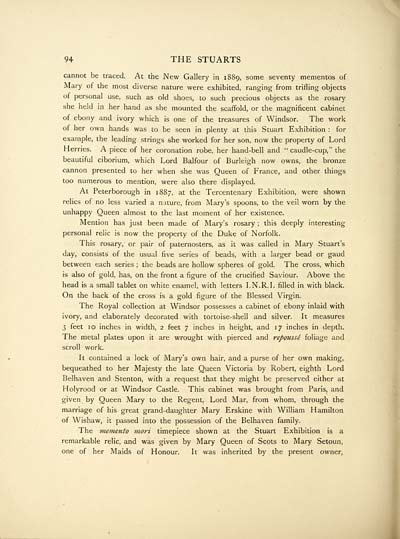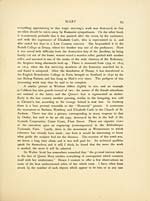Stuarts
(122) Page 94
Download files
Complete book:
Individual page:
Thumbnail gallery: Grid view | List view

94 THE STUARTS
cannot be traced. At the New Gallery in 1889, some seventy mementos of
Mary of the most diverse nature were exhibited, ranging from trifling objects
of personal use, such as old shoes, to such precious objects as the rosary
she held in her hand as she mounted the scaffold, or the magnificent cabinet
of ebony and ivory which is one of the treasures of Windsor. The work
of her own hands was to be seen in plenty at this Stuart Exhibition : for
example, the leading strings she worked for her son, now the property of Lord
Herries. A piece of her coronation robe, her hand-bell and " caudle-cup," the
beautiful ciborium, which Lord Balfour of Burleigh now owns, the bronze
cannon presented to her when she was Queen of France, and other things
too numerous to mention, were also there displayed.
At Peterborough in 1887, at trie Tercentenary Exhibition, were shown
relics of no less varied a nature, from Mary's spoons, to the veil worn by the
unhappy Queen almost to the last moment of her existence.
Mention has just been made of Mary's rosary ; this deeply interesting
personal relic is now the property of the Duke of Norfolk.
This rosary, or pair of paternosters, as it was called in Mary Stuart's
day, consists of the usual five series of beads, with a larger bead or gaud
between each series ; the beads are hollow spheres of gold. The cross, which
is also of gold, has, on the front a figure of the crucified Saviour. Above the
head is a small tablet on white enamel, with letters I. N.R.I, filled in with black.
On the back of the cross is a gold figure of the Blessed Virgin.
The Royal collection at Windsor possesses a cabinet of ebony inlaid with
ivory, and elaborately decorated with tortoise-shell and silver. It measures
3 feet 10 inches in width, 2 feet 7 inches in height, and 17 inches in depth.
The metal plates upon it are wrought with pierced and repousse" foliage and
scroll work.
It contained a lock of Mary's own hair, and a purse of her own making,
bequeathed to her Majesty the late Queen Victoria by Robert, eighth Lord
Belhaven and Stenton, with a request that they might be preserved either at
Holyrood or at Windsor Castle. This cabinet was brought from Paris, and
given by Queen Mary to the Regent, Lord Mar, from whom, through the
marriage of his great grand-daughter Mary Erskine with William Hamilton
of Wishaw, it passed into the possession of the Belhaven family.
The memento mori timepiece shown at the Stuart Exhibition is a
remarkable relic, and was given by Mary Queen of Scots to Mary Setoun,
one of her Maids of Honour. It was inherited by the present owner,
cannot be traced. At the New Gallery in 1889, some seventy mementos of
Mary of the most diverse nature were exhibited, ranging from trifling objects
of personal use, such as old shoes, to such precious objects as the rosary
she held in her hand as she mounted the scaffold, or the magnificent cabinet
of ebony and ivory which is one of the treasures of Windsor. The work
of her own hands was to be seen in plenty at this Stuart Exhibition : for
example, the leading strings she worked for her son, now the property of Lord
Herries. A piece of her coronation robe, her hand-bell and " caudle-cup," the
beautiful ciborium, which Lord Balfour of Burleigh now owns, the bronze
cannon presented to her when she was Queen of France, and other things
too numerous to mention, were also there displayed.
At Peterborough in 1887, at trie Tercentenary Exhibition, were shown
relics of no less varied a nature, from Mary's spoons, to the veil worn by the
unhappy Queen almost to the last moment of her existence.
Mention has just been made of Mary's rosary ; this deeply interesting
personal relic is now the property of the Duke of Norfolk.
This rosary, or pair of paternosters, as it was called in Mary Stuart's
day, consists of the usual five series of beads, with a larger bead or gaud
between each series ; the beads are hollow spheres of gold. The cross, which
is also of gold, has, on the front a figure of the crucified Saviour. Above the
head is a small tablet on white enamel, with letters I. N.R.I, filled in with black.
On the back of the cross is a gold figure of the Blessed Virgin.
The Royal collection at Windsor possesses a cabinet of ebony inlaid with
ivory, and elaborately decorated with tortoise-shell and silver. It measures
3 feet 10 inches in width, 2 feet 7 inches in height, and 17 inches in depth.
The metal plates upon it are wrought with pierced and repousse" foliage and
scroll work.
It contained a lock of Mary's own hair, and a purse of her own making,
bequeathed to her Majesty the late Queen Victoria by Robert, eighth Lord
Belhaven and Stenton, with a request that they might be preserved either at
Holyrood or at Windsor Castle. This cabinet was brought from Paris, and
given by Queen Mary to the Regent, Lord Mar, from whom, through the
marriage of his great grand-daughter Mary Erskine with William Hamilton
of Wishaw, it passed into the possession of the Belhaven family.
The memento mori timepiece shown at the Stuart Exhibition is a
remarkable relic, and was given by Mary Queen of Scots to Mary Setoun,
one of her Maids of Honour. It was inherited by the present owner,
Set display mode to:
![]() Universal Viewer |
Universal Viewer | ![]() Mirador |
Large image | Transcription
Mirador |
Large image | Transcription
Images and transcriptions on this page, including medium image downloads, may be used under the Creative Commons Attribution 4.0 International Licence unless otherwise stated. ![]()
| Histories of Scottish families > Stuarts > (122) Page 94 |
|---|
| Permanent URL | https://digital.nls.uk/95240515 |
|---|
| Description | A selection of almost 400 printed items relating to the history of Scottish families, mostly dating from the 19th and early 20th centuries. Includes memoirs, genealogies and clan histories, with a few produced by emigrant families. The earliest family history goes back to AD 916. |
|---|

